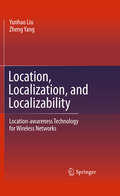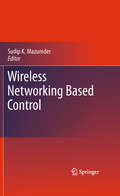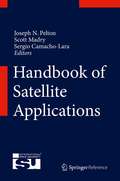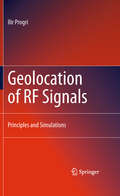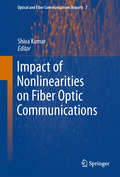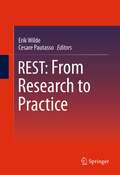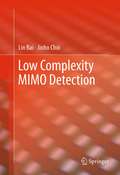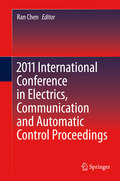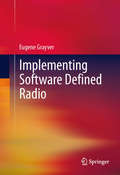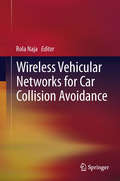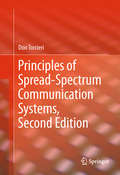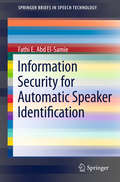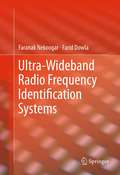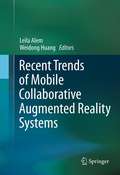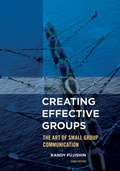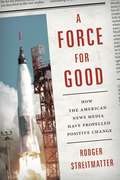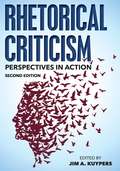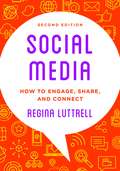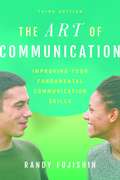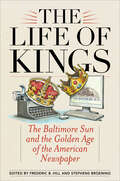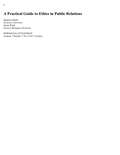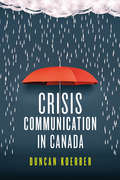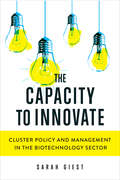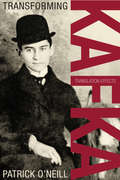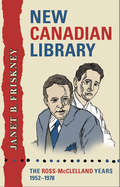- Table View
- List View
Location, Localization, and Localizability
by Yunhao Liu Zheng YangThis book reflects up-to-date research, fundamental theories, and key techniques of of wireless localization technology and error-controlling techniques. It also presents and discusses the issue of localizability, as well as privacy issues associated with LBS. This book encompasses the significant and quickly growing area of wireless localization technology. It presents comprehensive and up-to-date research in both fundamental theories and key techniques of network localization. In addition to localization approaches, it also is the first book to address the issue of localizability. The privacy issue of LBS technology is also discussed.
Wireless Networking Based Control
by Sudip K. MazumderThis book will have a broad appeal in the area of Wireless Networking-Based Control. Various engineering disciplines, control and communication science organizations will be interested in purchasing the book with a new, emerging, and important theme. Also, industry such as Honeywell and those (e.g. power industry, automotive industry, aerospace industry) interested in implementing wireless network control to express interest in purchasing this book.
Handbook of Satellite Applications
by Sergio Camacho-Lara Scott Madry Joseph N. PeltonTop space experts from around the world have collaborated to produce this comprehensive, authoritative, and clearly illustrated reference guide to the fast growing, multi-billion dollar field of satellite applications and space communications. This handbook, done under the auspices of the International Space University based in France, addresses not only system technologies but also examines market dynamics, technical standards and regulatory constraints. The handbook is a completely multi-disciplinary reference book that covers, in an in-depth fashion, the fields of satellite telecommunications, Earth observation, remote sensing, satellite navigation, geographical information systems, and geosynchronous meteorological systems. It covers current practices and designs as well as advanced concepts and future systems. It provides a comparative analysis of the common technologies and design elements for satellite application bus structures, thermal controls, power systems, stabilization techniques, telemetry, command and control (TTC), and orbital configurations. These common aspects are addressed in an integrated fashion to explain how all these space systems share similar design features, but also have quite specialized application packages to carry out their various missions. No other reference in print today provides such a comprehensive and in-depth guide to all forms of application satellites, including small sats as used by countries just beginning space application programs.
Geolocation of RF Signals
by Ilir ProgriGeolocation of RF Signals--Principles and Simulations offers an overview of the best practices and innovative techniques in the art and science of geolocation over the last twenty years. It covers all research and development aspects including theoretical analysis, RF signals, geolocation techniques, key block diagrams, and practical principle simulation examples in the frequency band from 100 MHz to 18 GHz or even 60 GHz. Starting with RF signals, the book progressively examines various signal bands - such as VLF, LF, MF, HF, VHF, UHF, L, S, C, X, Ku, and, K and the corresponding geolocation requirements per band and per application - to achieve required performance objectives of up to 0º precision. Part II follows a step-by-step approach of RF geolocation techniques and concludes with notes on state-of-the-art geolocation designs as well as advanced features found in signal generator instruments. Drawing upon years of practical experience and using numerous examples and illustrative applications, Ilir Progri provides a comprehensive introduction to Geolocation of RF Signals, and includes hands-on real world labs and applications using MATLAB in the areas of: RF signals specifications, RF geolocation distributed wireless communications networks and RF geolocation. Geolocation of RF Signals--Principles and Simulations will be of interest to government agency program managers industry professionals and engineers, academic researchers, faculty and graduate students who are interested in or currently designing, developing and deploying innovative geolocation of RF Signal systems.
Impact of Nonlinearities on Fiber Optic Communications
by Shiva KumarThis book covers the recent progress in fiber-optic communication systems with a main focus on the impact of fiber nonlinearities on the system performance. Over the past few years, there has been significant progress in coherent communication systems mainly because of the advances in digital signal processing techniques. This has led to renewed interest in fiber linear and nonlinear impairments and techniques to mitigate them in electrical domain. In this book, the reader will find all the important topics of fiber optic communication systems in one place with in-depth coverage by the experts of each subtopics. Pioneers from each of the sub-topics have been invited to contribute. Each chapter will have a section on fundamentals, review of literature survey and the recent developments. The reader will benefit from this approach since many of the conference proceedings and journal articles mainly focus on the authors' research work without spending space on preliminaries.
REST: From Research to Practice
by Cesare Pautasso Erik WildeThis volume provides an overview and an understanding of REST (Representational State Transfer). Discussing the constraints of REST the book focuses on REST as a type of web architectural style. The focus is on applying REST beyond Web applications (i.e., in enterprise environments), and in reusing established and well-understood design patterns when doing so. The reader will be able to understand how RESTful systems can be designed and deployed, and what the results are in terms of benefits and challenges encountered in the process. Since REST is relatively new as an approach for designing Web Services, the more advanced part of the book collects a number of challenges to some of the assumptions and constraints of REST, and looks at current research work on how REST can be extended and applied to scenarios that often are considered not to be a good match for REST. This work will help readers to reach a deeper understanding of REST on a practical as well as on an advanced level.
Low Complexity MIMO Detection
by Lin Bai Jinho ChoiLow Complexity MIMO Detection introduces the principle of MIMO systems and signal detection via MIMO channels. This book systematically introduces the symbol detection in MIMO systems. Includes the fundamental knowledge of MIMO detection and recent research outcomes for low complexity MIMO detection.
2011 International Conference in Electrics, Communication and Automatic Control Proceedings (Lecture Notes in Electrical Engineering #165)
by Ran Chen2011 International Conference in Electrics, Communication and Automatic Control Proceedings examines state-of-art and advances in Electrics, Communication and Automatic Control. This book presents developments in Power Conversion, Signal and image processing, Image & video Signal Processing. The conference brings together researchers, engineers, academic as well as industrial professionals from all over the world to promote the developments of Electrics, Communication and Automatic Control.
Implementing Software Defined Radio
by Eugene GrayverSoftware Defined Radio makes wireless communications easier, more efficient, and more reliable. This book bridges the gap between academic research and practical implementation. When beginning a project, practicing engineers, technical managers, and graduate students can save countless hours by considering the concepts presented in these pages. The author covers the myriad options and trade-offs available when selecting an appropriate hardware architecture. As demonstrated here, the choice between hardware- and software-centric architecture can mean the difference between meeting an aggressive schedule and bogging down in endless design iterations. Because of the author's experience overseeing dozens of failed and successful developments, he is able to present many real-life examples. Some of the key concepts covered are: Choosing the right architecture for the market - laboratory, military, or commercial, Hardware platforms - FPGAs, GPPs, specialized and hybrid devices, Standardization efforts to ensure interoperability and portabilitym State-of-the-art components for radio frequency, mixed-signal, and baseband processing. The text requires only minimal knowledge of wireless communications; whenever possible, qualitative arguments are used instead of equations. An appendix provides a quick overview of wireless communications and introduces most of the concepts the readers will need to take advantage of the material. An essential introduction to SDR, this book is sure to be an invaluable addition to any technical bookshelf.
Wireless Vehicular Networks for Car Collision Avoidance
by Rola NajaWireless Vehicular Networks for Car Collision Avoidance focuses on the development of the ITS (Intelligent Transportation Systems) in order to minimize vehicular accidents. The book presents and analyses a range of concrete accident scenarios while examining the causes of vehicular collision and proposing countermeasures based on wireless vehicular networks.The book also describes the vehicular network standards and quality of service mechanisms focusing on improving critical dissemination of safety information. With recommendations on techniques and protocols to consider when improving road safety policies in order to minimize crashes and collision risks.
Principles of Spread-Spectrum Communication Systems, Second Edition
by Don TorrieriThis book provides a concise but lucid explanation of the fundamentals of spread-spectrum systems with an emphasis on theoretical principles. Throughout the book, learning is facilitated by many new or streamlined derivations of the classical theory. Problems at the end of each chapter are intended to assist readers in consolidating their knowledge and to provide practice in analytical techniques. The choice of specific topics is tempered by the author’s judgment of their practical significance and interest to both researchers and system designers. The evolution of spread spectrum communication systems and the prominence of new mathematical methods in their design provided the motivation to undertake this new edition of the book. This edition is intended to enable readers to understand the current state-of-the-art in this field. More than 20 percent of the material in this edition is new, including a chapter on systems with iterative channel estimation, and the remainder of the material has been thoroughly revised.
Information Security for Automatic Speaker Identification
by Fathi E. El-SamieThe author covers the fundamentals of both information and communication security including current developments in some of the most critical areas of automatic speech recognition. Included are topics on speech watermarking, speech encryption, steganography, multilevel security systems comprising speaker identification, real transmission of watermarked or encrypted speech signals, and more. The book is especially useful for information security specialist, government security analysts, speech development professionals, and for individuals involved in the study and research of speech recognition at advanced levels.
Ultra-Wideband Radio Frequency Identification Systems
by Farid Dowla Faranak NekoogarUltra-wideband Radio Frequency Identification Systems describes the essentials of radio frequency identification (RFID)systems as well as their target markets. The book covers a study of commercially available RFID systems and characterizes their performance in terms of read range and reliability in the presence of conductive and dielectric materials. The capabilities and limitations of commercial RFID systems are reported followed by comprehensive discussions of the advantages and challenges of using ultra-wideband (UWB) technology for tag/reader communications. The book presents practical aspects of RFID system such as: EPC global and ISO standards, implementation, and target markets in a simple and easy to understand language.
Recent Trends of Mobile Collaborative Augmented Reality Systems
by Weidong Huang Leila AlemThe use of mobile collaborative AR has expended rapidly in recent years, due to the major advances in hardware and networking. The application areas are diverse and multidisciplinary. Recent Trends of Mobile Collaborative Augmented Reality Systems provides a historical overview of previous mobile collaborative AR systems, presents case studies of latest developments in current mobile collaborative AR systems, and latest technologies and system architectures used in this field. Recent Trends of Mobile Collaborative Augmented Reality Systems is designed for a professional audience composed of practitioners and researchers working in the field of augmented reality and human-computer interaction. Advanced-level students in computer science and electrical engineering focused on this topic will also find this book useful as a secondary text or reference.
Creating Effective Groups: The Art of Small Group Communication (Third Edition)
by Randy FujishinThis practical book gives students the fundamental knowledge and skills necessary to communicate more effectively and interact more productively in the small group setting. With the help of this book, any group member can learn the skills necessary to participate in and lead a task group in an effective, productive, and healthy manner. This third edition features all new sections on: . "The Power of Diversity" . "Critically Thinking About Yourself As A Communicator" . "Defensive vs. Supportive Climates" . "Ethical Communication" . "Time Management" . "Impromptu Speaking" . "The Spirit of Collaboration" As well as new end chapter exercises in several chapters focusing on Online Resources and Social Media. "
A Force for Good: How the American News Media Have Propelled Positive Change
by Rodger StreitmatterAmerica’s news media are relentlessly criticized as too negative, sensationalistic, profit-oriented, and biased, not to mention unpatriotic and a miserable failure at reflecting the nation’s diversity. The author argues, print and broadcast journalists have propelled significant social topics onto the public agenda and helped build support for change. This text draws on both historical and contemporary examples from a wide range of social contexts; the result is a fascinating tour of American history, social change, and the benefits of a robust media. To simply put, this book is driven by the thesis, that journalism has improved this country in an impressively broad range of areas.
Rhetorical Criticism, Second Edition: Perspectives In Action (Communication, Media, and Politics)
by Jim A. KuypersThis text provides a thorough, accessible, and well-grounded introduction to the breadth of approaches and perspectives comprising contemporary rhetorical criticism.
Social Media: How to Engage, Share, and Connect,
by Regina Luttrellappropriate use of social media in public relations, where the profession stands today and where it is headed in the future; and - real-world examples of successful social media campaigns. This book will become your go-to reference guide for all things social media-related as it applies to public relations and the everyday duties of PR professionals.
The Art Of Communication: Improving Your Fundamental Communication Skills (Third Edition)
by Randy FujishinThis third edition of The Art of Communication (previously titled Creating Communication) is a brief and practical introduction to speech communication. Emphasizing face-to-face communication, yet also addressing the role of technology and its influence on daily communication, Fujishin helps you develop greater understanding of how important communication skills are in your personal and professional life--and will inspire you to use these skills in ways that enlarge and improve the lives of others as well as your own. Fujishin employs a distinctively encouraging and conversational approach as he explains the basic communication skills necessary to improve in numerous contexts--including public speaking, small group, interpersonal, intercultural, leadership, interviewing, and technology-based communication. The result is an easy-to-read book that provides the tools to implement powerful changes in the ways you interact with others.
The Life of Kings: The Baltimore Sun and the Golden Age of the American Newspaper
by Frederic B. Hill Stephens BroeningIn an age when local daily papers with formerly robust reporting are cutting sections and even closing their doors, the contributors to The Life of Kings celebrate the heyday of one such paper, the Baltimore Sun, when it set the agenda for Baltimore, was a force in Washington, and extended its reach around the globe. Contributors like David Simon, creator of HBO’s The Wire, and renowned political cartoonist Kevin Kallaugher (better known as KAL), tell what it was like to work in what may have been the last golden age of American newspapers -- when journalism still seemed like “the life of kings” that H.L. Mencken so cheerfully remembered. The writers in this volume recall the standards that made the Sun and other fine independent newspapers a bulwark of civic life for so long. Their contributions affirm that the core principles they followed are no less imperative for the new forms of journalism: a strong sense of the public interest in whose name they were acting, a reverence for accuracy, and an obligation
A Practical Guide to Ethics in Public Relations
by Jamie Ward Regina LuttrellOn a daily basis, public relations practitioners are tasked with making ethical decisions, such as advising a client to fully disclose a corporate relationship or advocating for honesty when working with the media. <p><p>A Practical Guide to Ethics in Public Relations is designed for courses in contemporary studies of public relations and communications. This text highlights the delicate balance required to navigate the values and demands implicit to the field of public relations and those that underlie society as a whole. Students are encouraged to examine their own values and compare them to those commonly encountered in a professional setting.
Crisis Communication in Canada
by Duncan KoerberPrivate companies that respond poorly to a crisis may go bankrupt, wiping out investments and jobs. Charities that respond poorly to a crisis may lose donations, ending support for the most vulnerable. Professional athletes, religious leaders, CEOs, and politicians who respond poorly to a crisis may lose their long-standing careers and the respect of their colleagues, supporters, fans, and customers. This book offers both theory and practical help for organizations and professionals to deal effectively with crises. Crisis communication lessons have typically been the purview of public relations professionals. However, since the 1990s there has been a growing body of scholarly research on the topic. Crisis Communication in Canada offers a unique scholarly and professional contribution, synthesizing recent research and providing a context for practical advice. Written in clear and concise style, directed at beginners but rooted in research, this book will offer instructors and students a unique resource for the study and practice of crisis communication.
The Capacity to Innovate: Cluster Policy and Management in the Biotechnology Sector (Studies in Comparative Political Economy and Public Policy)
by Sarah GiestIn The Capacity to Innovate, Sarah Giest provides insight into the collaborative and absorptive capacities needed to provide public support to local innovation through cluster organizations. The book offers a detailed view of the vertical, multi-level, and horizontal dynamics in clusters and cluster policy and addresses how they are managed and supported. Using the biotechnology field as an example, Giest highlights challenges in the collaborative efforts of public bodies, private companies, and research institutes to establish a successful ecosystem of innovation in this sector. The book argues that cluster policy in collaboration with cluster organizations should focus on absorptive and collaborative capacity elements missing in the cluster context in order to improve performance. Currently, governments operate at different levels – from the local to the supranational – in order to support clusters, and cluster policies are often pursued alongside other programs, leading to uncoordinated efforts and ineffective cluster strategies. The Capacity to Innovate advocates for a coordinated effort by government and cluster organizations to support capacity elements lacking within the specific cluster context.
Transforming Kafka
by Patrick O'NeillLyrical, mysterious, and laden with symbolism, Franz Kafka's novels and stories have been translated into more than forty languages ranging from Icelandic to Japanese. In Transforming Kafka, Patrick O'Neill approaches these texts through the method he pioneered in Polyglot Joyce and Impossible Joyce, considering the many translations of each work as a single, multilingual "macrotext."Examining three novels - The Trial, The Castle, and America - and two short stories - "The Judgment" and "The Metamorphosis" - O'Neill offers comparative readings that consider both intertextual and intratextual themes. His innovative approach shows how comparing translations extends and expands the potential meanings of the text and reveals the subtle differences among the hundreds of translations of Kafka's work. A sophisticated analysis of the ways in which translation shapes, rearranges, and expands our understanding of literary works, Transforming Kafka is a unique approach to reading the works of a literary giant.
New Canadian Library
by Janet FriskneyIn the mid-1950s, much Canadian literature was out of print, making it relatively inaccessible to readers, including those studying the subject in schools and universities. When English professor Malcolm Ross approached Toronto publisher Jack McClelland in 1952 to propose a Canadian literary reprint series, it was still the accepted wisdom among publishers that Canadian literature was of insufficient interest to the educational market to merit any great publishing risks. Eventually convinced by Ross that a latent market for Canadian literary reprints did indeed exist, McClelland & Stewart launched the New Canadian Library (NCL) series in 1958, with Ross as its general editor. In 2008, the NCL will celebrate a half-century of publication.In New Canadian Library, Janet B. Friskney takes the reader through the early history of the NCL series, focusing on the period up to 1978 when Malcolm Ross retired as general editor. A wealth of archival resources, published reviews, and the NCL volumes themselves are used to survey the working relationship between Ross and McClelland, as well as the collaborative participation of those who, through the middle decades of the twentieth century, were committed to studying and nurturing Canada's literary heritage. To place the New Canadian Library in its proper historical context, Friskney examines the simultaneous development of Canadian literary studies as a legitimate area of research and teaching in academe and acknowledges the NCL as a milestone in Canadian publishing history.
